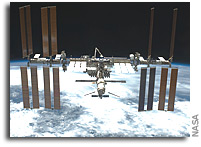NASA International Space Station Lead Increment Scientist’s Highlights For The First Week of August 2011

(Highlights: First Week of August 2011) — Ron Garan completed another session with the Scaling Body-Related Actions in the Absence of Gravity (Passages) experiment. Passages evaluates how astronauts interpret visual information in microgravity. This experiment tests hypothesis about human perception and provides information on how astronauts adjust to the novel conditions of spaceflight. These sessions may lead to virtual reality training models that could be used to better prepare astronauts for long-duration missions.
Garan performed a session with the Synchronized Position Hold, Engage, Reorient, Experimental Satellites (SPHERES). SPHERES is made up of bowling-ball sized free-flying spherical satellites that fly in the International Space Station cabin to test algorithms for spacecraft performing autonomous rendezvous and docking maneuvers. The space technologies for formation flight of small satellites could influence Earth-based applications of current satellite technologies including surveillance, mapping, communications and navigation.
Satoshi Furukawa performed a session with the LEGO bricks experiment. LEGO Bricks is an educational payload, made up of a series of toy LEGO kits that are assembled on orbit to demonstrate scientific concepts and to promote student interest in science, technology, engineering and mathematics. Crew members perform tasks to demonstrate simple science concepts and how Lego Bricks work differently in a microgravity environment.
Crew members opened the European Modular Cultivation System (EMCS) gas valves for a second run with the Plant Signaling experiment, which studies the effects of microgravity on plant growth. The NASA experiment is performed in collaboration with the European Space Agency. Images of the plants are captured and down-linked to Earth, while samples of the plants are harvested and returned to Earth for scientific analysis. The results of this experiment could lead to information that will aid in food production for future long duration space missions, and data to enhance crop production on Earth.
Garan completed his second session for the European Space Agency’s Sodium Loading in Microgravity (SOLO) experiment. Microgravity leads to an activation of sodium retaining hormones, which in turn worsens the breakdown of bone. SOLO studies the mechanisms of fluid and salt retention in the body during spaceflight by monitoring nutrient intake, collecting urine, measuring body mass and collecting blood.
For the Japan Aerospace Exploration Agency’s Try Zero G experiment, Furukawa completed the session entitled “Shooting for space medicine education,” in which he explained and illustrated the medical and health effects of microgravity on the body.
Try Zero G allows students to vote for and suggest physical tasks for JAXA astronauts to demonstrate the difference between microgravity in space and gravity on Earth for educational purposes.
Vic Cooley, Lead Increment Scientist
Expedition 27/28








